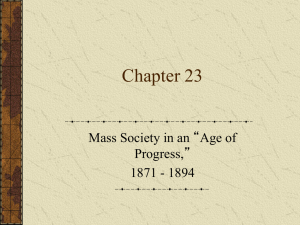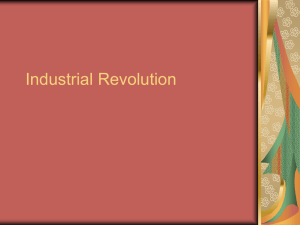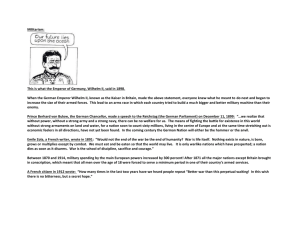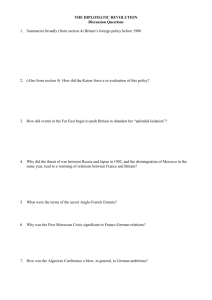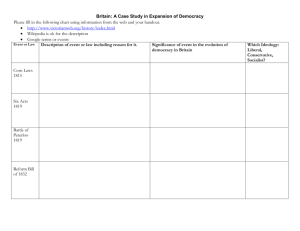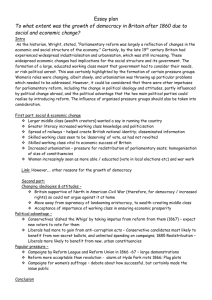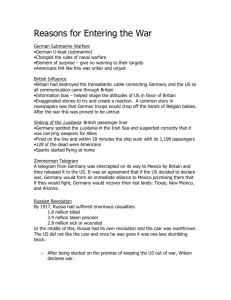23 - Warren County Schools
advertisement
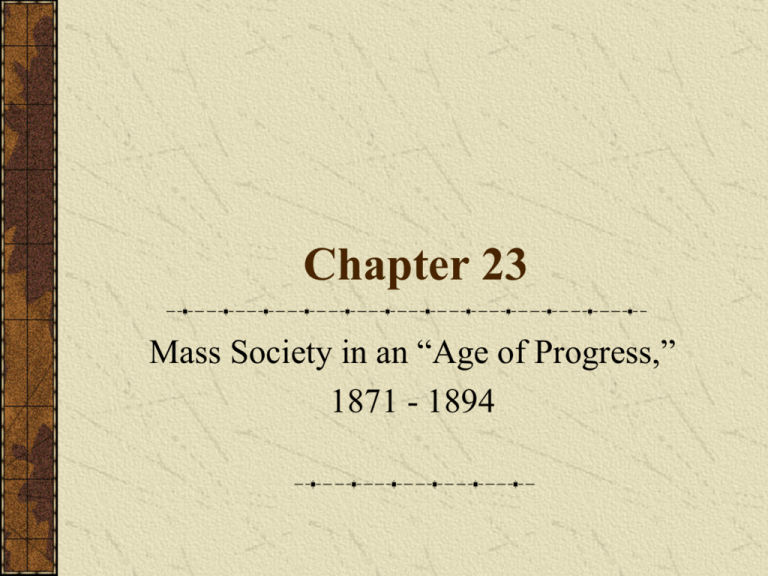
Chapter 23 Mass Society in an “Age of Progress,” 1871 - 1894 The Industrial Regions of Europe by 1914 ©2003 Wadsworth, a division of Thomson Learning, Inc. Thomson Learning™ is a trademark used herein under license. The Growth of Industrial Prosperity Second Industrial Revolution New Products Human progress is tied to greater consumption of material goods Substitution of steel for iron • Growth from 125,000 to 32 million tons Growth of chemical industry Electricity powers this revolution • Thomas Edison and Joseph Swan – light bulb • Alexander Graham Bell– telephone, 1876 • Guglielmo Marconi– radio waves across the Atlantic, 1901 • Siemens & Halske Electric railway in Berlin, 1879 Internal combustion engine • Mixture of gas and air first built in 1878 Automobile and airplane • Henry Ford (1863-1947) – mass production • Zeppelin airship, 1900 • Wright brothers, 1903 New markets post 1870 Urban consumers demand skyrockets National income growth • Real wages increase • Spend more on consumer goods Competition for foreign markets Cartels Protective tariffs by most nations • Growth in anti-free trade movements New Patterns in an Industrial Economy Depression, 1873-1895 Economic boom after 1895 La belle époque German Industrial Leadership Germany replaces Britain as the industrial leader of Europe • British suspicion of innovation Emerging industries of chemicals and heavy electric machinery Union of science and technology Japanese governmental planning and initiative European Economic Zones 1900 Europe into two economic zones Advance industrial core of Great Britain, Belgium France, the Netherlands, Germany, western part of the Austro-Hungarian Empire, and northern Italy Little industrial development in southern Italy, most of AustriaHungary, Spain, Portugal, the Balkan kingdoms, and Russia Agricultural growth causes a drop in agricultural prices Tariff barriers A World Economy Economic development in conjunction with growth in marine and railroad transportation Women and Work: New Job Opportunities Expanding service sector changes quality and quantity of employment opportunities “Right to work” Domesticity Sweatshops White-Collar Jobs Clerks, shop assistants and nurses Increased white-collar jobs creates shortage of male workers opening up opportunities for women Secretaries and teachers Freedom from “dirty work” of the lower-class world Prostitution Working-class girls flocked to the cities from the countryside Employment unstable and wages low Licensed and regulated Contagious Diseases Acts in Britain, 1870s and 1880s Organizing the Working Class Socialist Parties desires to improve living and working conditions for workers German Social Democratic Party (SPD) • Marxist rhetoric, improve the condition of the working class German Social Democrats • Socialist party Jean Jaurès (1859-1914) • French socialism Social Democratic Labor Party • Marxist, organized in Russia in 1898 Second International Revisionism and Nationalism Eduard Bernstein (1850-1932), Evolutionary Socialism, 1899 • Demise of capitalism not near • Bourgeoisie expanding • Proletariat improving • Discarded class struggle • Evolution not revolution Using democratic policy to create socialism Role of Trade Unions Develop slowly, initially set up as mutual aid societies Generally allied with Socialists, depending on the country England has the largest number of trade unionist preWWI German trade unions attached to political parties Anarchist Alternative Support in less industrialized and less democratic countries People inherently good but corrupted by state and society Mikhail Bakunin, use of assassination and violence Emergence of a Mass Society Population Growth and Emigration From 270 million to 460 million (1850-1910) Declining mortality rate • Medical discoveries and environmental conditions • Improved public sanitation • Improved diet Increased emigration • Between 1846 and 1932, 60 million Europeans left Europe, half to the United States, the other half to Canada and Latin America Transformation of the Urban Environment Growth of cities Improving Living Conditions Public Health Act of 1875 in Britain Clean water into the city Expulsion of sewage Housing Needs Reformer-philanthropists build model homes Port Sunlight by Lord Leverhulme, 1887 Garden city movement in Britain, Ebenezer Howard Octavia Hill • Nicer environment would encourage people to improve themselves British Housing Act, 1890 Redesigning the cities Redesign of Vienna and Paris Defensive walls pulled down Great boulevards New buildings Displaced population ©2003 Wadsworth, a division of Thomson Learning, Inc. Thomson Learning ™ is a trademark used herein under license. Population Growth in Europe, 18201900 The Social Structure of the Mass Society The Elite 5% of the population that controlled 30 to 40 percent of wealth Alliance of wealthy business elite and traditional aristocracy Industrial plutocrats The Middle Classes Upper middle class typically considered part of the Upper class, middle middle-class, lower middle-class Share common lifestyle and values that come to dominate society Professionals White-collar workers The Lower classes 80% of the European population Agriculture Skilled, semiskilled, unskilled workers in the urban working class The “Woman Question”: The Role of Women Marriage the only honorable and available career Elizabeth Poole Sanford • Women should avoid becoming self-sufficient Birth control emerges and birth rates decline slightly in early 20th century The Middle-class Family Domesticity Leisure time and holiday traditions Schooling of sons with functional knowledge to prepare for ones future Boy Scouts Working-class Family Daughters work until married 1890 to 1914 higher paying jobs made it possible to live on the husband’s wages Limit size of the family Infanticide/abortion Coitus interruptus Abortion abandonment Reduced work week Education and Leisure in an Age of Mass Society Mass education in state-run systems after 1850 Personal and social development Most countries provide a free and compulsory education at the primary level Needs of industrialization Need for an educated electorate to heighten patriotism and produce informed voters Differences in education of boys and girls Demand for Teachers Increased literacy Newspapers Mass Leisure Amusement parks Music and dance halls Tourism Thomas Cook pioneered the field in England Sports Recreation Professional sports teams and leagues developed Amusement parks Sundays The National State Western Europe: The Growth of Political Democracy continues Reform in Britain William Gladstone Suffrage: Reform Act of 1867 Reform: • English Reform Bill of 1884: agricultural workers given right to vote • Redistribution Act of 1885: Reorganized the election boroughs • Salaries paid to members of the House of Commons More people can run for office Ireland • Limited land reform • Charles Parnell demands home-rule • Home Rule Act, 1914 The Third Republic in France Second Empire collapses when French are defeated in the Franco-Prussian War Universal male suffrage1871 Radical republicans form independent government “The Commune” • Brutal regime divides the working and middle class even further Government troops break the commune Republican constitution establishes the Third Republic, 1875 General Georges Boulanger (1837-1891), 1889 • This Crisis rallied citizens to the cause of the Republic Louis Michel The Growth of Political Democracy Spain less effected by the innovations of the time King Alfonso XII Liberals and Conservatives Spanish-American War Barcelona 1909 Italy less effected by the innovations of the time Had pretensions of great power status Sectional differences in Italy Chronic turmoil beyond the government’s control Central and Eastern Europe: Persistence of the Old Order Germany Prussian military tradition that the Emperor commands Trappings of parliamentary government 1871 Constitution establishes nationhood Bismarck’s conservatism Kulturkampf Social Democratic Party Social welfare programs to lure workers to his Party Used coalitions to his benefit, dropping them when they became useless Austria-Hungary 1867 Constitution Nationality still not stable Prime Minister Count Edward von Taaffee, 1879-93 Problem of minorities worsened with 1907 universal male suffrage Imperial emergency decrees Parliamentary system in Hungary Russian Autocracy Alexander III, 1881-1894 Reform had been a mistake • Overturned and repressive measures return Nicholas II, 1894-1917 Weak Believed in absolute rule
